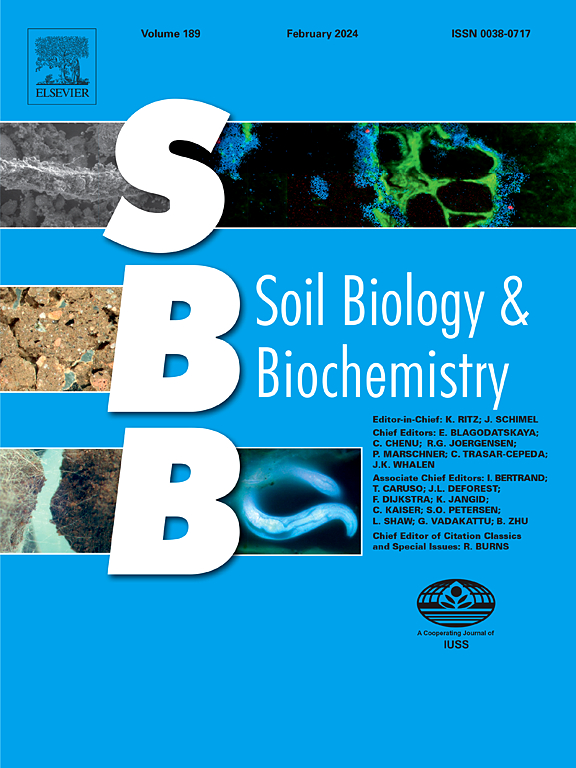Rhizosphere – detritusphere interactions stabilize soil carbon depending on plant litter traits
IF 10.3
1区 农林科学
Q1 SOIL SCIENCE
引用次数: 0
Abstract
Plant litter, the dominant source of soil organic carbon (SOC), enters as aboveground plant residues or belowground as rhizodeposition, forming hotspots of microbial SOC formation within the detritusphere and rhizosphere. The knowledge of microbial metabolism in these two hotspots help to reconcile much of the debate and contradictory evidence about litter effects on SOC stabilization. To investigate how rhizosphere–detritusphere interactions impact SOC formation, we quantified the particulate organic C (POC) and mineral-associated organic C (MAOC) pools in a field experiment receiving aboveground litter additions from six plant species varying in their litter quality. Rhizosphere effects, defined here as the activity around living roots compared to the soil with decomposing litter (detritusphere), on microbial biomass and activity increased with decreasing litter quality (high C:N ratio), reflecting a strategy in which plant roots acquire nutrients through interactions with rhizosphere microbes. Low-quality (high C:N) litter decreased the POC content in rhizosphere by 21 % but raised the MAOC content by 17 % relative to detritusphere, increasing the MAOC portion in SOC by 13 %. The rhizosphere effect on POC and MAOC pools was absent when high-quality (low C:N) litter was applied, presumably because the microbially-mediated nutrient release by mineralization matched the plant demands. These results indicate that rhizosphere effect contributed to more stable SOC than corresponding detritusphere under low-quality litter inputs, partly due to the efficient MAOC formation by rhizosphere microorganisms. Consequently, the interactive effects between rhizosphere and detritusphere on SOC pools crucially depend on litter traits, directing soil microbial efficiency and nutrient cycling.


根际-碎屑层的相互作用对土壤碳的稳定取决于植物凋落物的特征
植物凋落物是土壤有机碳(SOC)的主要来源,它们以地上植物残体或根际沉积的形式进入土壤,形成了腐殖层和根际微生物有机碳形成的热点。对这两个热点地区微生物代谢的了解有助于调和关于凋落物对有机碳稳定影响的许多争论和矛盾证据。为了研究根际-碎屑层相互作用如何影响有机碳的形成,我们在野外试验中量化了颗粒有机碳(POC)和矿物相关有机碳(MAOC)库,这些有机碳库接受了6种不同凋落物质量的植物的地上凋落物添加。根际效应,这里定义为与分解凋落物(碎屑层)的土壤相比,活根周围的活动对微生物生物量和活动的影响随着凋落物质量的降低(高C:N比)而增加,反映了植物根系通过与根际微生物的相互作用获取营养的策略。低质量(高碳氮比)凋落物使根际POC含量降低了21%,而相对于碎屑层MAOC含量提高了17%,使有机碳中MAOC的比例提高了13%。当施用优质(低C:N)凋落物时,根际对POC和MAOC池的影响不存在,可能是因为微生物介导的矿化养分释放与植物需求相匹配。这些结果表明,在低质量凋落物输入条件下,根际效应对土壤有机碳的贡献比相应的腐肉层更稳定,部分原因是根际微生物有效地形成了MAOC。因此,根际和碎屑层对有机碳库的交互作用主要取决于凋落物性状,从而指导土壤微生物效率和养分循环。
本文章由计算机程序翻译,如有差异,请以英文原文为准。
求助全文
约1分钟内获得全文
求助全文
来源期刊

Soil Biology & Biochemistry
农林科学-土壤科学
CiteScore
16.90
自引率
9.30%
发文量
312
审稿时长
49 days
期刊介绍:
Soil Biology & Biochemistry publishes original research articles of international significance focusing on biological processes in soil and their applications to soil and environmental quality. Major topics include the ecology and biochemical processes of soil organisms, their effects on the environment, and interactions with plants. The journal also welcomes state-of-the-art reviews and discussions on contemporary research in soil biology and biochemistry.
 求助内容:
求助内容: 应助结果提醒方式:
应助结果提醒方式:


